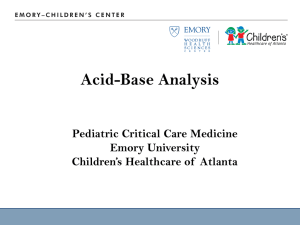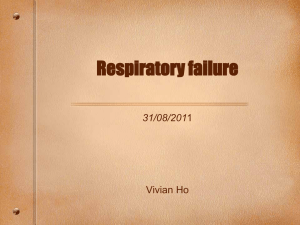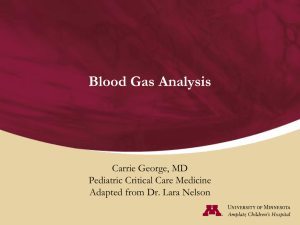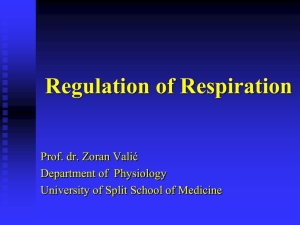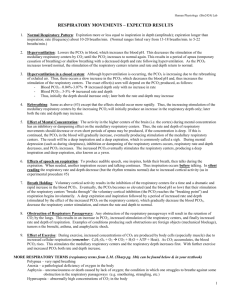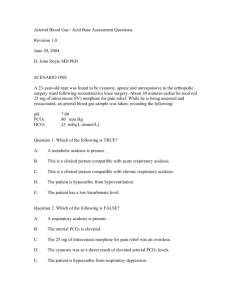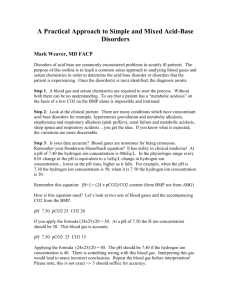- NERC Open Research Archive
advertisement
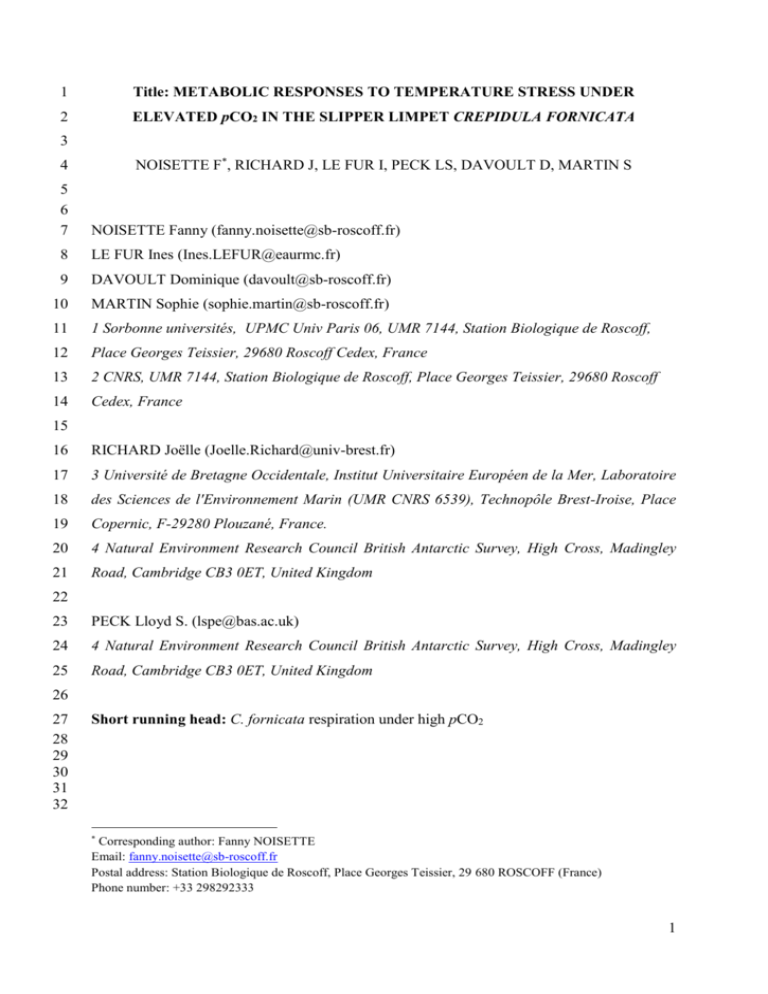
1 Title: METABOLIC RESPONSES TO TEMPERATURE STRESS UNDER 2 ELEVATED pCO2 IN THE SLIPPER LIMPET CREPIDULA FORNICATA 3 NOISETTE F*, RICHARD J, LE FUR I, PECK LS, DAVOULT D, MARTIN S 4 5 6 7 NOISETTE Fanny (fanny.noisette@sb-roscoff.fr) 8 LE FUR Ines (Ines.LEFUR@eaurmc.fr) 9 DAVOULT Dominique (davoult@sb-roscoff.fr) 10 MARTIN Sophie (sophie.martin@sb-roscoff.fr) 11 1 Sorbonne universités, UPMC Univ Paris 06, UMR 7144, Station Biologique de Roscoff, 12 Place Georges Teissier, 29680 Roscoff Cedex, France 13 2 CNRS, UMR 7144, Station Biologique de Roscoff, Place Georges Teissier, 29680 Roscoff 14 Cedex, France 15 16 RICHARD Joëlle (Joelle.Richard@univ-brest.fr) 17 3 Université de Bretagne Occidentale, Institut Universitaire Européen de la Mer, Laboratoire 18 des Sciences de l'Environnement Marin (UMR CNRS 6539), Technopôle Brest-Iroise, Place 19 Copernic, F-29280 Plouzané, France. 20 4 Natural Environment Research Council British Antarctic Survey, High Cross, Madingley 21 Road, Cambridge CB3 0ET, United Kingdom 22 23 PECK Lloyd S. (lspe@bas.ac.uk) 24 4 Natural Environment Research Council British Antarctic Survey, High Cross, Madingley 25 Road, Cambridge CB3 0ET, United Kingdom 26 27 28 29 30 31 32 Short running head: C. fornicata respiration under high pCO2 * Corresponding author: Fanny NOISETTE Email: fanny.noisette@sb-roscoff.fr Postal address: Station Biologique de Roscoff, Place Georges Teissier, 29 680 ROSCOFF (France) Phone number: +33 298292333 1 33 ABSTRACT 34 35 In the current context of environmental change, ocean acidification is predicted to affect the 36 cellular processes, physiology and behavior of all marine organisms, impacting survival, 37 growth and reproduction. In relation to thermal tolerance limits, the effects of elevated pCO2 38 could be expected to be more pronounced at the upper limits of the thermal tolerance window. 39 Our study focused on Crepidula fornicata, an invasive gastropod which colonized shallow 40 waters around European coasts during the 20th century. We investigated the effects of 10 41 weeks’ exposure to current (380 µatm) and elevated (550, 750, 1000 µatm) pCO2 on this 42 engineer species using an acute temperature increase (1°C 12h-1) as the test. Respiration rates 43 were measured on both males (small individuals) and females (large individuals). Mortality 44 increased suddenly from 34°C, particularly in females. Respiration rate in C. fornicata 45 increased linearly with temperature between 18°C and 34°C, but no differences were detected 46 between the different pCO2 conditions either in the regressions between respiration rate and 47 temperature, or in Q10 values. In the same way, condition indices were similar in all the pCO2 48 treatments at the end of the experiment but decreased from the beginning of the experiment. 49 This species was highly resistant to acute exposure to high temperature regardless of pCO2 50 levels, even though food was limited during the experiment. C. fornicata appears to have 51 either developed resistance mechanisms or a strong phenotypic plasticity to deal with 52 fluctuations of physico-chemical parameters in their habitat. This suggests that this invasive 53 species may be more resistant to future environmental changes compared to its native 54 competitors. 55 56 Keywords: CO2 stress, invasive species, ocean acidification, Q10, respiration, temperate 57 waters 2 58 INTRODUCTION 59 60 As part of global change, ocean acidification is caused by increasing anthropogenic 61 CO2 emissions which have increased since the beginning of the industrial revolution 62 (Solomon et al., 2007). Future pCO2 increases are predicted to reduce the pH of surface 63 waters by 0.3 - 0.4 units by the end of the century (Caldeira & Wickett, 2003). Such decreases 64 will produce changes in carbon and carbonate seawater chemistry through decreased 65 carbonate ion concentrations (CO32-) and a lower calcium carbonate saturation state (Ω). 66 These changes are predicted to have major consequences for marine life (Fabry et al., 2008; 67 Kroeker et al., 2013b) and, especially, could have broad impacts on physiological functions of 68 heterotrophic marine organisms (Pörtner, 2008; Hofmann & Todgham, 2010). 69 The decrease in pH is likely to have a wide range of effects on marine invertebrates 70 via shifts in acid-base homeostasis, changes in metabolism and energy balance (Pörtner et al., 71 2005), leading to effects on somatic growth (Berge et al., 2006; Thomsen & Melzner, 2010), 72 respiration (Melatunan et al., 2011; Schalkhausser et al., 2013), excretion (Liu & He, 2012), 73 calcification (Gazeau et al., 2007; Wood et al., 2008; Watson et al., 2012) or feeding rates 74 (Bamber, 1990; Navarro et al., 2013). Many marine invertebrates exposed to elevated pCO2 75 have exhibited metabolic depression (Willson & Burnett, 2000; Michaelidis et al., 2005; 76 Navarro et al., 2013) as a decrease in respiration rate while others have remained unaffected 77 (Gutowska et al., 2008; Lannig et al., 2010; Clark et al., 2013) or even increased their 78 metabolic rate (Wood et al., 2008; Beniash et al., 2010). These responses are highly species- 79 specific and may vary with organism size (Beniash et al., 2010). The resilience of the species 80 studied, and the capacity to regulate metabolism under stressful conditions are also important 81 (Pörtner, 2008). These physiological impacts are likely to have broad effects on the survival, 82 growth and reproduction of marine species (Shirayama & Thornton, 2005; Byrne, 2011), 3 83 which would lead to changes in community structure from altered diversity and abundances 84 (Hale et al., 2011; Kroeker et al., 2013a). 85 These physiological impacts are likely modulated by temperature because temperature 86 is a primary driver of physiological function in ectotherms (Hofmann & Todgham, 2010). 87 Increasing temperature affects the rate of all biochemical reactions, and hence cellular 88 processes and physiological functions (Clarke, 1983; Pörtner, 2012), increasing metabolic 89 costs within a limited thermal tolerance window (Peck et al., 2002; Marshall et al., 2003). 90 The interactive effects of increased temperature and elevated CO2 concentrations are 91 predicted to impair physiological processes (Clarke, 2003; Pörtner, 2008) by narrowing the 92 thermal tolerance window of the organisms (Metzger et al., 2007; Lannig et al., 2010) and 93 elevating vulnerability to extreme temperature (Schalkhausser et al., 2012). 94 In a context of global change, non-indigenous species are expected to be favored in 95 their introduced area (Dukes & Mooney, 1999; Occhipinti-Ambrogi, 2007) mainly because 96 robustness to abiotic variation is often a trait that determines the success of invasive of a 97 species (Hellmann et al., 2008; Lenz et al., 2011). Climatic changes in the physical 98 environment will likely affect the distribution, spread, abundance, impacts and interactions of 99 species, possibly to the advantage of introduced organisms (Occhipinti-Ambrogi, 2007). Thus 100 our study focused on the response of an invasive Calyptraeidae gastropod living on western 101 European coasts, but which originates from North East America. The slipper limpet, 102 Crepidula fornicata (Linné 1758) was introduced in Europe at the end of the 19th century, 103 mainly with oysters (Crassostrea gigas) which were imported for farming (Blanchard, 1995), 104 and has subsequently colonized European coasts from southern Sweden to southern France 105 (Blanchard, 1997). C. fornicata has significant impacts on biodiversity and ecosystem 106 functioning where it has established (De Montaudouin et al., 1999; Decottignies et al., 2007; 107 Martin et al., 2007). It lives in shallow sites, especially in bays and estuaries where very high 4 108 densities of over one thousand individuals m-2 have been reported (Blanchard, 1995). C. 109 fornicata is known to be strongly resistant to environmental variations, particularly 110 temperature and salinity (Blanchard, 1995; Blanchard, 1997; Diederich & Pechenick, 2013). 111 In light of the different ecological and physiological characteristics of C. fornicata, it is 112 important to investigate the impact of future pCO2 levels, and determine its resistance 113 capacities to high levels of stress to assess the likely future impact of this engineer species in 114 the ecosystems to which it was introduced. 115 The present study was designed to investigate the metabolic responses of C. fornicata 116 to high pCO2 conditions during temperature stress. Short-term experimental approaches using 117 faster temperature elevations than natural changes provide valuable insight into physiological 118 responses of marine invertebrates in term of their ability to resist high levels of stress or their 119 lethal temperature (Sokolova & Pörtner, 2003; Peck et al., 2004; Pörtner et al., 2006; Richard 120 et al., 2012). Following the hypothesis that CO2 stress will increase sensitivity to temperature 121 change, we evaluated changes in oxygen-consumption of C. fornicata individuals previously 122 reared under elevated pCO2 for 10 weeks during a rapid temperature increase (1°C 12h-1). 123 Respiration rates were measured as a proxy for metabolism on males (small individuals) and 124 females (large individuals), as in this species there is sexual dimorphism in size. 125 126 FMATERIAL & METHODS 127 128 Biological material 129 Crepidula fornicata stacks were collected by SCUBA divers on 4 February 2010, in 130 Morlaix Bay (northwest Brittany, France), at the “Barre des Flots” site (3°53.015'W; 131 48°40.015'N) at a depth of 10 meters and at an in situ temperature of 11.6°C (SOMLIT: 132 Service d’Observation de la Mer et du LITtoral data). They were transferred directly to 5 133 aquaria at the Station Biologique de Roscoff where they were held in natural unfiltered 134 seawater at a temperature around 10°C, until they were used in experiments starting on 10 135 March 2010. 136 Males and females at the top and the bottom of stacks respectively, were selected, 137 separated and individually labelled. Small males (23.31 ± 0.16 mm length), which were still 138 slightly mobile, were placed individually on 3 cm Petri dishes one month before the beginning 139 of the trials. Dead individual shells at the base of stacks were kept as the substratum under the 140 largest living immobile females (47.53 ± 0.25 mm length). In C. fornicata, size cannot be 141 discriminated from sex because this is a protandrous hermaphroditic organism, changing sex 142 with age and size (Coe 1938). All individuals were gently brushed to remove epibionts and 143 biofilm from their shells before proceeding to the metabolic measurements. 144 Condition indices (CI) were calculated on a pool of 20 specimens in March, before the 145 beginning of the experiment, and on all remaining living and recently dead individuals (male 146 n = 74; female n = 99) at the end of the temperature increase on 29 May 2010. Shell dry 147 weight (DWShell), shell length and tissue dry weight (DWTissue) were determined separately on 148 each individual after drying at 60°C for 48h. Specimens were then ignited in a muffle furnace 149 at 520°C for 6 h, with tissue ash-free dry weight (AFDWTissue) being obtained by difference. 150 CI were calculated as: 151 CI = (AFDWTissue / DWShell) × 100. 152 Mortality was checked daily during the experiment. Individuals with no reaction when 153 the foot was stimulated were classed as dead and removed from the tanks. 154 155 Experimental conditions and set-up 156 After distributing randomly in each of twelve 10-L aquarium tanks comprising the 157 experimental flow-through system (as described in Noisette et al., 2013), 120 males and 120 6 158 females (i.e. 10 individuals of each sex per aquarium) were held in different pCO2 conditions 159 between 13 March and 29 May 2010. At the beginning of the experiment, pH was gradually 160 decreased (by bubbling CO2) over four days at 0.1 pH units day-1 from 8.1 until the required 161 pH was reached. Specimens were subsequently held for ten weeks in four different pCO2 162 conditions: a current pCO2 of 380 µatm (pHT = 8.07), and three elevated pCO2 levels of 550 163 µatm (pHT = 7.94), 750 µatm (pHT = 7.82) and 1000 µatm (pHT = 7.77). The elevated pCO2 164 values corresponded to different scenarios predicted by the Intergovernmental Panel on 165 Climate Change (IPCC) for the end of the century (Solomon et al., 2007) and were selected 166 according to the recommendations of Barry et al., (2010). pCO2 was adjusted by bubbling 167 CO2-free air (current pCO2) or pure CO2 (elevated pCO2) in four 100 L header tanks (1 per 168 pCO2 condition) supplied with natural unfiltered seawater pumped from the sea, directly at the 169 foot of the Station Biologique de Roscoff. Seawater was continually delivered by gravity from 170 each header tank to three aquaria per pCO2 condition at a constant rate of 9 L h-1 (renewal 171 rate: 90% total aquarium volume h-1). pCO2 was monitored and controlled by a feedback 172 system (IKS Aquastar, Karlsbad, Germany) that regulated the addition of gas in the header 173 tanks. pH values of the pH-stat system were adjusted from daily measurements of pH on the 174 total scale (pHT) in the aquaria using a pH meter (HQ40D, Hach Lange, Ltd portable LDOTM, 175 Loveland, Colorado, USA) calibrated using Tris/HCl and 2-aminopyridine/HCl buffers 176 (Dickson et al., 2007). The twelve aquaria were placed in four thermostatic baths where 177 temperature was controlled to ± 0.2 °C using 100 - 150 W submersible heaters. 178 Before the rapid temperature increase experiment, C. fornicata individuals were 179 maintained in the different pCO2 treatments for 10 weeks while temperature was raised 180 successively to mimic the natural rate of temperature change from winter to summer. 181 Temperature was maintained at 10°C from the beginning of the trial to 29 March. It was 182 raised to 13°C from 5 to 19 April and to 16°C from 26 April to 18 May 2010. To reach these 7 183 set levels the temperature was increased by 0.5°C day-1 until the new set temperature was 184 achieved. During the experiment, animals were naturally fed by the phytoplankton provided 185 by unfiltered seawater. 186 The rapid temperature increase experiment was conducted between the 18 and 29 May 187 2010. In all four pCO2 treatments, temperature was increased from 16 to 36°C at 1°C 12h-1. C. 188 fornicata oxygen consumption was measured (see below) both in small and large individuals 189 in the different pCO2 treatments during this rapid temperature increase. 190 191 Seawater parameters 192 Seawater parameters were monitored throughout the experiment. pHT and temperature 193 were recorded daily in each of the 12 aquaria using a pH meter (HQ40D, Hach Lange, Ltd 194 portable LDOTM, Loveland, Colorado, USA). Total alkalinity was determined every 3 weeks 195 by 0.01N HCl potentiometric titration on an automatic titrator (Titroline alpha, Schott SI 196 Analytics, Mainz, Germany). Seawater carbonate chemistry, i.e. exact CO2 partial pressure 197 (pCO2) and saturation state of aragonite were calculated in each pCO2 condition using 198 CO2SYS software (Lewis & Wallace, 1998) using constants from Mehrbach et al., (1973) 199 refitted by Dickson & Millero, (1987). Mean values (± standard error, SE) of the parameters 200 in each pCO2 treatment are presented in Table 1. 201 202 Oxygen consumption measurements 203 During the rapid temperature increase trial (18 - 29 May 2010), oxygen consumption 204 of 6 randomly selected labeled individuals of each sex (2 per aquaria) was measured in each 205 of the pCO2 treatments every two days, at 18, 22, 26, 30 and 34°C. Respiration rates were 206 determined using closed incubations in 75 mL (males) or 180 mL (females) acrylic chambers 207 (Engineering & Design Plastics Ltd, Cambridge, UK) filled with water from the same 8 208 aquarium (see methods in Morley et al., 2007). Chambers were placed in their respective 209 aquaria during incubations to keep the temperature constant. Incubations varied between 1 h 210 and 3 h depending on temperature and were halted before oxygen saturation fell below 80% 211 saturation. Control incubations without animals (n = 1 control incubation / aquarium / 212 measurement) were carried out to allow correction for microbial activity in seawater. 213 Respiration rates were calculated from the differences in measurements of oxygen 214 concentration during trials and controls using a non-invasive fiber-optical system (FIBOX 3, 215 PreSens, Regensburg, Germany) made up of an optical fiber and reactive oxygen spots 216 attached to the inner wall of the chambers. These spots were calibrated with 0% and 100% 217 oxygen buffers made from the manufacturer instructions. 0% O2 buffer was prepared by 218 dissolving 10 g of Na2SO3 in 1 L of seawater and 100% O2 buffer was prepared by bubbling 219 air in 1L of seawater for 20 min to achieve oxygen saturation. Previous experiments had 220 demonstrated that oxygen consumption remained linear during all the incubation periods. 221 Chamber contents were mixed gently by inverting chambers several times before each oxygen 222 measurement. Respiration (R) rates (in µmol O2 g-1 AFDW h-1) were corrected for oxygen 223 consumption in controls and calculated as: R = – (ΔO2 × V) / (Δt × AFDWTissue) 224 225 where ΔO2 (µmol O2 L-1) is the difference between initial and final O2 concentrations during 226 the incubation, V (L) is the chamber volume minus the individual C. fornicata volume, Δt (h) 227 is the incubation time and AFDWTissue (g) is the tissue ash free dry weight of the slipper 228 limpet incubated. 229 Q10 coefficients were calculated by using the standard equation: 230 Q10 = (RH/ RL) 10 / (TH – TL) 231 where TL and TH were the lowest and highest temperature reached and RL and RH the 232 respiration rates in these temperature respectively. 9 233 234 Statistical analyses 235 All statistical analyses were performed using R version 2.15.0 (R Core Team 2013) 236 and STATISTICA software. A logistic regression (general linear model, GLM) was applied 237 to test the differences in mortalities between the different pCO2 treatments and between sex 238 with temperature as the linear variable. The effects of pCO2, sex and the interaction of these 239 two factors on condition index (CI) at the end of the experiment and on Q10 values were 240 investigated by 2-way analysis of variance (ANOVA). Linear regressions between respiration 241 rates and increasing temperatures were fitted in the four different pCO2 treatments for males 242 and females separately. Differences between pCO2 treatments were explored using an 243 ANCOVA with pCO2 and sex as fixed factors and temperature as co-variable.. Normality was 244 assessed using the Kolmogorov-Smirnov test and Levene’s test was used to ensure that 245 variances were homogenous. All the results are presented as mean ± standard error (SE). 246 247 RESULTS 248 249 Mortality occurred between 34 and 36°C for females and 22 and 36°C for males 250 (Figure 1). There were no significant differences in mortality between the different pCO2 251 treatments (GLM, df = 3, F = 0.680, p = 0.565) or between males and females (GLM, df = 1, 252 F = 0.580, p = 0.449). Moreover, the interaction between factors pCO2 and sex of the 253 individuals was not significant (GLM, df = 3; F = 0.21; p = 0.888). At pCO2 levels of 380, 254 550, 750 and 1000 µatm, the mortality was 29, 19, 19, and 24 for females and 28, 6, 8, and 6 255 for males . At the end of the acute temperature increase nearly twice the number of females 256 had died (91) compared with the males (48) (χ² test, p < 0.05). 10 257 The mean condition index before the start of the experiment was 3.00 ± 0.27 (n=10). It 258 varied at the end of the experiment between 1.69 ± 0.13 for males at pCO2 of 380 µatm and 259 2.41 ± 0.27 for females at pCO2 of 550 µatm (Table 2). There were no effects of pCO2 , sex 260 or the interaction of these two factors on the condition index at the end of the trial (Table 2). 261 However, the condition index from the beginning of the experiment (3.00 ± 0.27) was 262 different from the mean condition index including all pCO2 conditions (2.11 ± 0.07) at the end 263 of the trial (t-test, df = 181, t = 3.159, p = 0.002), which means that CI in both males and 264 females decreased significantly from the start to the end of the experiment (Figure 2). 265 Female respiration rates varied between 0.51 µmol O2 g-1 AFDW h-1 at 18°C and 266 pCO2 of 750 µatm and 91.62 µmol O2 g-1 AFDW h-1 at 32°C and pCO2 of 380 µatm. Males 267 had higher rates, which ranged between 5.13 µmol O2 g-1 AFDW h-1 at 18°C and pCO2 of 380 268 µatm and 175.51 µmol O2 g-1 AFDW h-1 at 32°C and pCO2 of 380 (Figure 3). 269 Relationships between respiration rate and temperature were linear at each pCO2 level 270 (Figure 3). Respiration rose significantly with increasing temperature in all pCO2 treatments, 271 for both males and females (Table 3, all p-values < 0.02). There were no significant 272 differences between the slopes of the different regressions among the pCO2 treatments or 273 between sexes (analysis of slopes, df = 3, F = 1.1, p = 0.346). The intercepts of the different 274 regressions also did not significantly vary among pCO2 (ANCOVA, df = 3, F = 0.350, p = 275 0.789), but there were difference between males and females (ANCOVA, df = 1, F = 62.63, p 276 < 0.001). 277 Q10 values ranged from 1.24 to 2.40 for females and from 1.36 to 2.77 for males 278 among the different pCO2 treatments (Figure 2). There was no significant pCO2 effect on Q10 279 values for either males or females (Table 2). Across all pCO2 treatments, females had 280 significantly lower Q10 values than males with means of 1.61 ± 0.11 and 2.00 ± 0.12 for 11 281 females and males, respectively (Table 2). The interaction between pCO2 and sex, however, 282 was not significant (Table 2). 283 284 DISCUSSION 285 286 Independently of the impact of pCO2 we planned to test, one of the major issues of this 287 study was food limitation which was unintentionally imposed on the C. fornicata individuals 288 in the experiments. This food limitation was detected because the decrease in condition 289 indices (CI) of both males and females from the beginning to the end of the experiment. Such 290 decreases in CI are usually related to food quantity or quality supplied to organisms (Norkko 291 & Thrush, 2006). Animals were maintained in unfiltered seawater which carried natural 292 phytoplankton at a concentration between 0.2 and 1 µg Chl a L-1 (SOMLIT data). The water 293 renewal in the aquarium was maintained constant at a rate of 0.9 L h-1 (i.e. 90% of the total 294 volume of each aquarium changed per hour). Water supply in our experimental system was 295 likely too low to provide sufficient food for the experimental animals, which thus relied on 296 internal energy reserves and so decreased their CI. A similar outcome was reported for 297 mussels by Mackenzie et al. (2014). 298 The use of stored reserves was similar in the different pCO2 conditions as CI at the end 299 of the experiment did not differ between the different pCO2 treatments, and this was the case 300 for both sexes. Previous studies have shown interspecific variability in the responses of 301 condition indices under high pCO2 levels, ranging from a lack of effect (Cummings et al., 302 2011; Clark et al., 2013; Sanders et al., 2013) to large changes in condition under high pCO2 303 levels (Hiebenthal et al., 2013; Range et al., 2014). Energy availability is a major component 304 in mitigating the effects of ocean acidification (Pansch et al., 2014). Studies have shown that 305 an abundant food supply might counteract even overcome the negative effects of high pCO2 12 306 on adult and juvenile bivalves (Melzner et al., 2011; Thomsen et al., 2013). Thus, it is 307 important to consider that in this study C. fornicata were under limited food conditions when 308 interpreting their metabolic responses to elevated pCO2 conditions during the temperature 309 rise. The data here are representative of conditions where there is temperature stress and food 310 supplies are limited, conditions that can occur in the field. 311 The limitation of food supply was not markedly more important in any of our reduced 312 pH conditions as there were no differences in mortality rates between the different pCO2 313 treatments in C. fornicata males and females. This is a different outcome to that reported for 314 some other mollusk species held in elevated pCO2 levels (Shirayama & Thornton, 2005; 315 Beniash et al., 2010). However, similarly to our study, Pansh et al., (2014) showed that food 316 availability had no impact on mortalities of the barnacle Amphibalanus improvises held in 317 different pCO2 conditions. In the present study, important mortalities started to occur from 318 32°C and they became larger at and above 34°C for both males and females. These values are 319 consistent with the upper lethal temperature recorded for C. fornicata by Diederich & 320 Pechenick, (2013) in a laboratory study investigating a population from Rhode Island, USA, 321 in which only 40% of the adults survived after a 3 h exposure to 34°C, and all died after a 3 h 322 exposure to 36°C. Mortality was higher in females (larger individuals) than in males (small 323 individuals) even if, male started to die at lower temperatures than females. Similarly, Peck et 324 al., (2009) demonstrated for 14 species that smaller species survived to higher temperatures 325 than large ones when temperature was raised at 1°C day-1, and Peck et al., (2013) showed that 326 juveniles had higher upper temperature limits than adults in 4 species of marine invertebrates 327 at warming rates of 1°C day-1 and 1°C 3days-1. The mechanisms setting temperature limits at 328 acute rates of warming may not be energy availability (Peck et al., 2014) and females, which 329 had more energetic reserves than males, may thus have not had an advantage. 13 330 Despite the decreases in CI, mean respiration rates of C. fornicata at 18°C and pCO2 331 of 380 µatm were 31 and 26 µmol O2 g-1 AFDW h-1 for males and females, respectively, 332 which are close to the middle of the range of in situ values reported for wild individuals from 333 the Bay of Brest (Brittany, France) (6 to 63 µmol O2 g-1 AFDW h-1: Martin et al., 2006). This 334 indicates that animals in the experiments here had similar oxygen consumption than wild 335 specimens and were not metabolically depressed under insufficient food supply. In both C. 336 fornicata males and females, respiration rates increased with temperature, as previously 337 demonstrated for this species by Newell & Kofoed, (1977) and most ectotherm metabolic 338 rates are correlated positively with temperature (Cossins & Bowler, 1987). Respiration rates 339 were higher in C. fornicata males than in females regardless of the temperature. Generally, 340 mass-specific respiration rates of small individuals are higher than those of larger ones 341 because metabolic rate (normalized to the biomass) decreases with increasing organisms size 342 (von Bertalanffy, 1951; Parsons et al., 1984). 343 The relationship between oxygen consumption and temperature here for C. fornicata 344 was similar in all the different pCO2 treatments. The slopes and intercepts of the regressions 345 were not significantly different across the four pCO2 conditions which means temperature 346 effect on respiration rate was not affected by the different pCO2 levels in males or females. In 347 constrast to our results, Lannig et al., (2010) found that an acute temperature rise 348 (1.25°C/12h) caused a more rapid increase in metabolic rate in Crassostrea gigas under 349 elevated pCO2 conditions, and there was a synergistic effect of temperature and pCO2. The 350 lack of difference in respiration between animals held in different pCO2 conditions may be 351 related to a stronger ability to up-regulate their metabolism under a temperature stress 352 irrespective of pCO2. Thus, under warming conditions, C. fornicata can generate sufficient 353 energy to cope with any effects of decreased pH (Wood et al., 2010). Q10 values were also 354 similar across pCO2 treatments in both males and females and they were within the expected 14 355 range of values recorded for marine invertebrates (Branch et al., 1988; Marshall et al., 2003). 356 Even if C. fornicata individuals were food limited, their oxygen consumption remained 357 unaffected by elevated pCO2. A similar lack of pCO2 effect was reported for growth and shell 358 strength of the barnacle A. improvisus (Pansch et al., 2014). In our study, the low food supply 359 did not appear to affect the resistance or resilience of C. fornicata to CO2 stress. 360 Several studies investigating the response of mollusk respiration to elevated pCO2 361 have demonstrated metabolic depression under high pCO2 in both bivalves and gastropods 362 (Michaelidis et al., 2005; Bibby et al., 2007; Fernandez-Reiriz et al., 2011; Melatunan et al., 363 2011; Liu & He, 2012; Navarro et al., 2013). Conversely, others observed no pCO2 effect on 364 mollusk respiration and general metabolism (Gazeau et al., 2007; Marchant et al., 2010; 365 Fernandez-Reiriz et al., 2012; Clark et al., 2013) as reported in our study. In some rare cases, 366 O2 consumption was reported to increase under high pCO2 conditions (Wood et al., 2010; 367 Cummings et al., 2011). The effects of high CO2 concentrations on metabolism appear 368 species-specific and depend on resistance capacities of the organisms (Melzner et al., 2009). 369 It has been widely reported that exposure to environmental high pCO2 levels leads to changes 370 in homeostasis and extracellular acid-base balance counterbalanced by metabolic depression 371 in many cases (Pörtner et al., 2005; Pörtner, 2008), although it should be noted, as above, that 372 metabolic depression is often not seen in high pCO2 conditions. Differences in acid-base 373 regulatory capacities by increasing HCO3- internal concentrations (Michaelidis et al., 2005; 374 Gutowska et al., 2010) or H+ excretion (Pörtner et al., 2005) are taxon specific and are more 375 or less effective in mitigating the effects of hypercapnia. It has also been suggested that 376 organisms could maintain low metabolic rates without controlling internal pH by not using 377 pH-sensitive oxygen-binding pigments (Thomsen et al., 2010; Hiebenthal et al., 2013). Such 378 mechanisms may be crucial factors in explaining the observed variation in sensitivities and 379 resistances of marine invertebrates to elevated pCO2 conditions (Gutowska et al., 2010). 15 380 It is important to note here that many of the studies to date on the effects of elevated 381 pCO2 on organisms are short-term and acute (e.g. Tomanek et al., 2011), not reflecting the 382 long-term trade off in energy balance and physiological changes associated with acclimation 383 of new environmental conditions (Clark et al., 2013). For example, metabolic depression acts 384 as a time-limited compensation strategy to survive unfavorable condition such as high CO2 385 concentrations (Guppy & Withers, 1999; Willson & Burnett, 2000). Because C. fornicata 386 were held for 10 weeks in the different pCO2 treatments in this investigation, it is likely there 387 was enough time for them to acclimate to the new pH, and no difference in oxygen 388 consumption was detected between the different pCO2 conditions. However, the energetic cost 389 likely produced by the negative effects of elevated pCO2 may either be relatively small , or 390 difficult to maintain over longer time periods. This could be seen in impacts on other 391 physiological processes than respiration (Catarino et al., 2012). For example, Bibby et al., 392 (2008) demonstrated that exposure to hypercapnic conditions may compromise the ability to 393 express an immune response in mussels. They showed that Mytilus edulis phagocytosis 394 declined as function of decreased pH. In the same way, Matozzo et al., (2012) showed that 395 elevated pCO2 and temperature may strongly affect haemocyte functionality in the bivalves 396 Chamelea gallina and Mytilus galloprovincialis. Other cellular processes have also been 397 shown to be negatively impacted by high CO2 concentrations, including protein synthesis in 398 the sipunculid Sipunculus nudus (Langenbuch et al., 2006) or enzyme activities in C. gallina 399 and M. galloprovincialis (Matozzo et al., 2013). However, studies of the impact of reduced 400 pH on immune systems have generally been of short duration and it would be interesting to 401 investigate other physiological parameters than respiration (e.g. calcification, protein 402 production, immunity regulation, fertility) in C. fornicata acclimated over several months in 403 the different pCO2 conditions predicted for the end of the century. As a coastal species 404 adapted to relatively large fluctuations of abiotic parameters, C. fornicata in this study were 16 405 strongly resistant to both elevated pCO2 and increased temperature. Indeed, resistance to high 406 pCO2 levels can also come from pre-acclimation or pre-adaptation to fluctuations in the 407 environment where species live (Burnett, 1997). Species living in environments with large 408 abiotic variation have a high phenotypic plasticity which can allow them to survive in 409 stressful conditions (Hofmann & Todgham, 2010). Coastal organisms are more exposed to 410 physico-chemical variations than their open-ocean counterparts that live in more stable 411 thermal and pH environments (Berge et al., 2006; Peck et al., 2006). Species living in shallow 412 waters tolerate not only seasonal and extreme temperature events but also periodic large 413 fluctuations in seawater pH, driven by biological process that sequester and release large 414 amounts of CO2 (Beniash et al., 2010). This exposure to a wide environmental variation has 415 likely led to the evolution of resistance mechanisms to abiotic factors including variations in 416 pCO2 and/or pH (Lannig et al., 2010). 417 C. fornicata is an invasive species which has successfully colonized European coastal 418 shallow waters. This species is likely to have high phenotypic plasticity and resilience to 419 physico-chemical variations that determined its success. Indeed, successful invasive species 420 generally share characteristics that allow them to establish, colonize and expand their range. 421 Among these characteristics, tolerance to environmental stress is one of the most common 422 (Lenz et al., 2011). In a global change context, the movement of physico-chemical conditions 423 away from the optimum increases the energy required by marine species to fuel the extra 424 processes entrained to resist the stresses involved and to maintain homesostasis. This may 425 result in changes in overall physiological condition (Cummings et al., 2011) that could impact 426 ecological processes and community interactions. The high resilience to altered pCO2/low pH 427 levels observed here for C. fornicata may confer a competitive advantage to this invasive 428 species over taxonomically or functionally related species (Lenz et al., 2011). For example, 429 the performance of the scallop Pecten maximus, which is one of the C. fornicata competitors 17 430 (Thouzeau et al., 2000; Fresard & Boncoeur, 2006), has been shown to be negatively affected 431 by high pCO2 levels (Schalkhausser et al., 2013). These different sensitivities to 432 environmental factors will likely dictate “winners” and “losers” among marine species that 433 could lead to a restructuring of benthic communities. With other studies, our data suggest this 434 restructuring could favor invasive species as evidence is building that shows they are more 435 resistant to change than their native competitors (Dukes & Mooney, 1999; Occhipinti- 436 Ambrogi, 2007). 437 438 439 440 441 442 443 444 445 446 447 ACKNOWLEDGMENTS 448 The authors thank the Marine Operations and Services Department from the Station 449 Biologique de Roscoff for the underwater sampling and the help for system building. This 450 work was supported by the CALCAO project funded from the Region Bretagne, and by the 451 Interreg IVa France (Channel) – England Marinexus project no. 4073 funded by the FEDER 452 programme. It also contributes to the ‘‘European Project on Ocean Acidification’’ (EPOCA) 453 which received funding from the European Community’s Seventh Framework Programme 454 (FP7/2007-2013) under grant agreement n° 211384 18 455 REFERENCES 456 Bamber R (1990) The effects of acidic seawater on three species of lamellibranch mollusc. 457 Journal of Experimental Marine Biology and Ecology 143: 181-191 458 Barry JP, Tyrrell T, Hansson L, Plattner GK, Gattuso JP (2010) Atmospheric CO2 targets for 459 ocean acidification perturbation experiments. In: Riebesell U. FVJ, Hansson L. & 460 Gattuso J.-P. (ed) Guide to best practices for ocean acidification research and data 461 reporting, Luxembourg: Publications Office of the European Union, pp 260 462 Beniash E, Ivanina A, Lieb NS, Kurochkin I, Sokolova IM (2010) Elevated level of carbon 463 dioxide affects metabolism and shell formation in oysters Crassostrea virginica. 464 Marine Ecology-Progress Series 419: 95-108 465 Berge JA, Bjerkeng B, Pettersen O, Schaanning MT, Øxnevad S (2006) Effects of increased 466 sea water concentrations of CO2 on growth of the bivalve Mytilus edulis L. 467 Chemosphere 62: 681-687 468 Bibby R, Cleall-Harding P, Rundle S, Widdicombe S, Spicer J (2007) Ocean acidification 469 disrupts induced defences in the intertidal gastropod Littorina littorea. Biology Letters 470 3: 699-701 471 472 473 474 475 476 Bibby R, Widdicombe S, Parry H, Spicer J, Pipe R (2008) Effects of ocean acidification on the immune response of the blue mussel Mytilus edulis. Aquatic Biology 2: 67-74 Blanchard M (1995) Origine et état de la population de Crepidula fornicata (Gastropoda Prosobranchia) sur le littoral français. Haliotis 24: 75-86 Blanchard M (1997) Spread of the slipper limpet Crepidula fornicata (L. 1758) in Europe. Current state and consequences. Scientia Marina 61: 109-118 477 Branch GM, Borchers P, Brown CR, Donnelly D (1988) Temperature and food as factors 478 influencing oxygen consumption of intertidal organisms, particularly limpets. 479 American Zoologist 28: 137-146 19 480 481 Burnett LE (1997) The challenges of living in hypoxic and hypercapnic aquatic environments. American Zoologist 37: 633-640 482 Byrne M (2011) Impact of ocean warming and ocean acidification on marine invertebrate life 483 history stages: vulnerabilities and potential for persistence in a changing ocean. In: 484 Gibson R, Atkinson R, Gordon J, Smith I, Hughes D (eds) Oceanography and Marine 485 Biology: An Annual Review. Taylor & Francis, pp 1-42 486 Caldeira K, Wickett ME (2003) Anthropogenic carbon and ocean pH. Nature 425: 365-365 487 Catarino AI, Bauwens M, Dubois P (2012) Acid-base balance and metabolic response of the 488 sea urchin Paracentrotus lividus to different seawater pH and temperatures. 489 Environmental Science and Pollution Research 19: 2344-2353 490 Clark MS, Thorne MAS, Amaral A, Vieira F, Batista FM, Reis J, Power DM (2013) 491 Identification of molecular and physiological responses to chronic environmental 492 challenge in an invasive species: the Pacific oyster, Crassostrea gigas. Ecology and 493 Evolution 3: 3283-3297 494 495 496 497 Clarke A (1983) Life in cold water: the physiological ecology of polar marine ectotherms. Oceanography and Marine Biology 21: 341-453 Coe WR (1938) Influence of association on the sexual phases of gastropods having protandric consecutive sexuality I. The Biological Bulletin 75: 274-285 498 Cossins AR, Bowler K (1987) Temperature biology of animals. Chapman and Hall London 499 Cummings V, Hewitt J, Van Rooyen A, Currie K, Beard S, Thrush S, Norkko J, Barr N, 500 Heath P, Halliday NJ, Sedcole R, Gomez A, McGraw C, Metcalf V (2011) Ocean 501 acidification at high latitudes: potential effects on functioning of the antarctic bivalve 502 Laternula elliptica. Plos One 6: e16069 20 503 De Montaudouin X, Audemard C, Labourg P-J (1999) Does the slipper limpet (Crepidula 504 fornicata, L.) impair oyster growth and zoobenthos biodiversity? A revisited 505 hypothesis. Journal of Experimental Marine Biology and Ecology 235: 105-124 506 Decottignies P, Beninger PG, Rincé Y, Riera P (2007) Trophic interactions between two 507 introduced suspension-feeders, Crepidula fornicata and Crassostrea gigas, are 508 influenced by seasonal effects and qualitative selection capacity. Journal of 509 Experimental Marine Biology and Ecology 342: 231-241 510 511 512 Dickson AG, Millero FJ (1987) A comparison of the equilibrium constants for the dissociation of carbonic acid in seawater media. Deep Sea Research 34: 1733-1743 Dickson AG, Sabine CL, Christian JR (2007) Guide to best practices for ocean CO2 513 measurements PICES special publication. 514 Organization, Sidney, British Columbia, pp 176 North Pacific Marine Science 515 Diederich CM, Pechenik JA (2013) Thermal tolerance of Crepidula fornicata (Gastropoda) 516 life history stages from intertidal and subtidal subpopulations. Marine Ecology- 517 Progress Series 486: 173-187 518 519 520 521 Dukes JS, Mooney HA (1999) Does global change increase the success of biological invaders? Trends in Ecology & Evolution 14: 135-139 Fabry VJ, Seibel BA, Feely RA, Orr JC (2008) Impacts of ocean acidification on marine fauna and ecosystem processes. Ices Journal of Marine Science 65: 414-432 522 Fernandez-Reiriz MJ, Range P, Alvarez-Salgado XA, Espinosa J, Labarta U (2012) Tolerance 523 of juvenile Mytilus galloprovincialis to experimental seawater acidification. Marine 524 Ecology-Progress Series 454: 65-74 525 Fernandez-Reiriz MJ, Range P, Alvarez-Salgado XA, Labarta U (2011) Physiological 526 energetics of juvenile clams Ruditapes decussatus in a high CO2 coastal ocean. Marine 527 Ecology-Progress Series 433: 97-105 21 528 Fresard M, Boncoeur J (2006) Costs and benefits of stock enhancement and biological 529 invasion control: the case of the Bay of Brest scallop fishery. Aquatic Living 530 Resources 19: 299-305 531 532 Gazeau F, Quiblier C, Jansen JM, Gattuso J-P, Middelburg JJ, Heip CHR (2007) Impact of elevated CO2 on shellfish calcification. Geophysical Research Letters 34: 5 533 Guppy M, Withers P (1999) Metabolic depression in animals: physiological perspectives and 534 biochemical generalizations. Biological Reviews of the Cambridge Philosophical 535 Society 74: 1-40 536 Gutowska MA, Melzner F, Langenbuch M, Bock C, Claireaux G, Pörtner H-O (2010) Acid- 537 base regulatory ability of the cephalopod (Sepia officinalis) in response to 538 environmental hypercapnia. Journal of Comparative Physiology B 180: 323-335 539 Gutowska MA, Pörtner H-O, Melzner F (2008) Growth and calcification in the cephalopod 540 Sepia officinalis under elevated seawater pCO2. Marine Ecology-Progress Series 373: 541 303-309 542 Hale R, Calosi P, McNeill L, Mieszkowska N, Widdicombe S (2011) Predicted levels of 543 future ocean acidification and temperature rise could alter community structure and 544 biodiversity in marine benthic communities. Oikos 120: 661-674 545 Hellmann JJ, Byers JE, Bierwagen BG, Dukes JS (2008) Five potential consequences of 546 climate change for invasive species. Cinco Consecuencias Potenciales del Cambio 547 Climático para Especies Invasoras. Conservation Biology 22: 534-543 548 Hiebenthal C, Philipp EE, Eisenhauer A, Wahl M (2013) Effects of seawater pCO2 and 549 temperature on shell growth, shell stability, condition and cellular stress of Western 550 Baltic Sea Mytilus edulis (L.) and Arctica islandica (L.). Marine Biology 160: 2073- 551 2087 22 552 553 Hofmann GE, Todgham AE (2010) Living in the now: physiological mechanisms to tolerate a rapidly changing environment. Annual Review of Physiology 72: 127-145 554 Kroeker KJ, Gambi MC, Micheli F (2013a) Community dynamics and ecosystem 555 simplification in a high-CO2 ocean. Proceedings of the National Academy of Sciences 556 110: 12721-12726 557 Kroeker KJ, Kordas RL, Crim R, Hendriks IE, Ramajo L, Singh GS, Duarte CM, Gattuso J-P 558 (2013b) Impacts of ocean acidification on marine organisms: quantifying sensitivities 559 and interaction with warming. Global Change Biology 19: 1884-1896 560 Langenbuch M, Bock C, Leibfritz D, Pörtner H-O (2006) Effects of environmental 561 hypercapnia on animal physiology: A C-13 NMR study of protein synthesis rates in 562 the marine invertebrate Sipunculus nudus. Comparative Biochemistry and Physiology 563 A-Molecular & Integrative Physiology 144: 479-484 564 Lannig G, Eilers S, Pörtner H-O, Sokolova IM, Bock C (2010) Impact of ocean acidification 565 on energy metabolism of oyster, Crassostrea gigas - Changes in metabolic pathways 566 and thermal response. Marine Drugs 8: 2318-2339 567 Lenz M, da Gama BAP, Gerner NV, Gobin J, Groner F, Harry A, Jenkins SR, Kraufvelin P, 568 Mummelthei C, Sareyka J, Xavier EA, Wahl M (2011) Non-native marine 569 invertebrates are more tolerant towards environmental stress than taxonomically 570 related native species: Results from a globally replicated study. Environmental 571 Research 111: 943-952 572 Lewis E, Wallace DWR (1998) Program developed for CO2 system calculations. Carbon 573 Dioxide Information Analysis Center, Oak Ridge National Laboratory, U.S. 574 Department of Energy 23 575 Liu W, He M (2012) Effects of ocean acidification on the metabolic rates of three species of 576 bivalve from southern coast of China. Chinese Journal of Oceanology and Limnology 577 30: 206-211 578 Mackenzie CL, Ormondroyd GA, Curling SF, Ball RJ, Whiteley NM, Malham SK (2014) 579 Ocean warming, more than acidification, reduces shell strength in a commercial 580 shellfish species during food limitation. Plos One 9: e86764 581 Marchant HK, Calosi P, Spicer JI (2010) Short-term exposure to hypercapnia does not 582 compromise feeding, acid-base balance or respiration of Patella vulgata but 583 surprisingly is accompanied by radula damage. Journal of the Marine Biological 584 Association of the United Kingdom 90: 1379-1384 585 Marshall DJ, Perissinotto R, Holley JF (2003) Respiratory responses of the mysid 586 Gastrosaccus brevifissura (Peracarida : Mysidacea), in relation to body size, 587 temperature and salinity. Comparative Biochemistry and Physiology A-Molecular & 588 Integrative Physiology 134: 257-266 589 Martin S, Thouzeau G, Chauvaud L, Jean F, Guérin L (2006) Respiration, calcification, and 590 excretion of the invasive slipper limpet, Crepidula fornicata L.: Implications for 591 carbon, carbonate, and nitrogen fluxes in affected areas. Limnology & Oceanography 592 51: 1996-2007 593 Martin S, Thouzeau G, Richard M, Chauvaud L, Jean F, Clavier J (2007) Benthic community 594 respiration in areas impacted by the invasive mollusk Crepidula fornicata. Marine 595 Ecology-Progress Series 347: 51-60 596 Matozzo V, Chinellato A, Munari M, Bressan M, Marin MG (2013) Can the combination of 597 decreased pH and increased temperature values induce oxidative stress in the clam 598 Chamelea gallina and the mussel Mytilus galloprovincialis? Marine Pollution Bulletin 599 72: 34-40 24 600 Matozzo V, Chinellato A, Munari M, Finos L, Bressan M, Marin MG (2012) First evidence of 601 immunomodulation in bivalves under seawater acidification and increased 602 temperature. Plos One 7: e33820 603 Mehrbach C, Culberso.Ch, Hawley JE, Pytkowic RM (1973) Measurement of apparent 604 dissociation-constants of carbonic-acid in seawater at atmospheric-pressure. 605 Limnology & Oceanography 18: 897-907 606 Melatunan S, Calosi P, Rundle SD, Moody AJ, Widdicombe S (2011) Exposure to elevated 607 temperature and pCO2 reduces respiration rate and energy status in the periwinkle 608 Littorina littorea. Physiological and Biochemical Zoology 84: 583-594 609 Melzner F, Gutowska MA, Langenbuch M, Dupont S, Lucassen M, Thorndyke MC, Bleich 610 M, Pörtner H-O (2009) Physiological basis for high CO2 tolerance in marine 611 ectothermic animals: pre-adaptation through lifestyle and ontogeny? Biogeosciences 6: 612 2313-2331 613 Melzner F, Stange P, Trubenbach K, Thomsen J, Casties I, Panknin U, Gorb SN, Gutowska 614 MA (2011) Food supply and seawater pCO2 impact calcification and internal shell 615 dissolution in the blue mussel Mytilus edulis. Plos One 6: e24223 616 Metzger R, Sartoris FJ, Langenbuch M, Pörtner H-O (2007) Influence of elevated CO2 617 concentrations on thermal tolerance of the edible crab Cancer pagurus. Journal of 618 Thermal Biology 32: 144-151 619 Michaelidis B, Ouzounis C, Paleras A, Pörtner H-O (2005) Effects of long-term moderate 620 hypercapnia on acid-base balance and growth rate in marine mussels Mytilus 621 galloprovincialis. Marine Ecology-Progress Series 293: 109-118 622 Morley SA, Peck LS, Miller AJ, Pörtner HO (2007) Hypoxia tolerance associated with 623 activity reduction is a key adaptation for Laternula elliptica seasonal energetics. 624 Oecologia 153: 29-36 25 625 Navarro JM, Torres R, Acuña K, Duarte C, Manriquez PH, Lardies M, Lagos NA, Vargas C, 626 Aguilera V (2013) Impact of medium-term exposure to elevated pCO2 levels on the 627 physiological energetics of the mussel Mytilus chilensis. Chemosphere 90: 1242-1248 628 629 Newell RC, Kofoed LH (1977) Adjustment of components of energy-balance in gastropod Crepidula fornicata in response to thermal acclimation. Marine Biology 44 : 275-286 630 Noisette F, Duong G, Six C, Davoult D, Martin S (2013) Effects of elevated pCO2 on the 631 metabolism of a temperate rhodolith Lithothamnion corallioides grown under different 632 temperatures. Journal of Phycology 49: 746-757 633 Norkko J, Thrush SF (2006) Ecophysiology in environmental impact assessment: implications 634 of spatial differences in seasonal variability of bivalve condition. Marine Ecology 635 Progress Series 326: 175-186 636 Occhipinti-Ambrogi A (2007) Global change and marine communities: Alien species and 637 climate change. Marine Pollution Bulletin 55: 342-352Pansch C, Schaub I, Havenhand 638 J, Wahl M (2014) Habitat traits and food availability determine the response of marine 639 invertebrates to ocean acidification. Global Change Biology 20: 265-277 640 Pansch C, Schaub I, Havenhand J, Wahl M (2014) Habitat traits and food availability 641 determine the response of marine invertebrates to ocean acidification. Global Change 642 Biology 20: 265-277 643 644 Parsons TR, Takahashi M, Hargrave B (1984) Biological oceanographic processes (3rd ed). In: (Eds) BH (ed), Oxford, pp 330 645 Peck LS, Clark MS, Morley SA, Massey A, Rossetti H (2009) Animal temperature limits and 646 ecological relevance: effects of size, activity and rates of change. Functional Ecology 647 23: 248-256 26 648 Peck LS, Convey P, Barnes DKA (2006) Environmental constraints on life histories in 649 antarctic ecosystems: Tempos, timings and predictability, Biological Reviews 81: 75- 650 109 651 652 Peck LS, Morley SA, Richard J, Clark MS (2014) Acclimation and thermal tolerance in Antarctic marine ectotherms. Journal of Experimental Biology 217: 16-22 653 Peck LS, Pörtner H-O, Hardewig I (2002) Metabolic demand, oxygen supply, and critical 654 temperatures in the Antarctic bivalve Laternula elliptica. Physiological and 655 Biochemical Zoology 75: 123-133 656 657 658 659 660 661 Peck LS, Souster T, Clark MS (2013) Juveniles are more resistant to warming than adults in 4 species of Antarctic marine invertebrates. PLoS One 8: e66033 Peck LS, Webb KE, Bailey DM (2004) Extreme sensitivity of biological function to temperature in Antarctic marine species. Functional Ecology 18: 625-630 Pörtner H-O (2008) Ecosystem effects of ocean acidification in times of ocean warming: a physiologist's view. Marine Ecology-Progress Series 373: 203-217 662 Pörtner H-O (2012) Integrating climate-related stressor effects on marine organisms: unifying 663 principles linking molecule to ecosystem-level changes. Marine Ecology-Progress 664 Series 470: 273-290 665 Pörtner H-O, Langenbuch M, Michaelidis B (2005) Synergistic effects of temperature 666 extremes, hypoxia, and increases in CO2 on marine animals: from Earth history to 667 global change. Journal of Geophysical Research-Oceans 110: C09S10 668 Pörtner H-O, Peck LS, Hirse T (2006) Hyperoxia alleviates thermal stress in the Antarctic 669 bivalve, Laternula elliptica: evidence for oxygen limited thermal tolerance. Polar 670 Biology 29: 688-693 671 672 R Core Team (2013) R: a language and environment for statistical computing. R Foundation for Statistical Computing, Vienna, Austria 27 673 Range P, Chicharo MA, Ben-Hamadou R, Pilo D, Fernandez-Reiriz MJ, Labarta U, Marin 674 MG, Bressan M, Matozzo V, Chinellato A, Munari M, El Menif NT, Dellali M, 675 Chicharo L (2014) Impacts of CO2-induced seawater acidification on coastal 676 Mediterranean bivalves and interactions with other climatic stressors. Regional 677 Environmental Change 14 (Suppl 1): S19-S30 678 Richard J, Morley SA, Deloffre J, Peck LS (2012) Thermal acclimation capacity for four 679 Arctic marine benthic species. Journal of Experimental Marine Biology and Ecology 680 424: 38-43 681 Sanders MB, Bean TP, Hutchinson TH, Le Quesne WJF (2013) Juvenile king scallop, Pecten 682 maximus, is potentially tolerant to low levels of ocean acidification when food is 683 unrestricted. Plos One 8: e74118 684 Schalkhausser B, Bock C, Stemmer K, Brey T, Pörtner H-O, Lannig G (2013) Impact of 685 ocean acidification on escape performance of the king scallop, Pecten maximus, from 686 Norway. Marine Biology 160: 1995-2006 687 Shirayama Y, Thornton H (2005) Effect of increased atmospheric CO2 on shallow water 688 marine benthos. Journal of Geophysical Research: Oceans 110 (C09S08): 1-8 689 Sokolova IM, Pörtner H-O (2003) Metabolic plasticity and critical temperatures for aerobic 690 scope in a eurythermal marine invertebrate (Littorina saxatilis, Gastropoda : 691 Littorinidae) from different latitudes. Journal of Experimental Biology 206: 195-207 692 Solomon S, Quin D, Manning M, Chen Z, Marquis M, Averyt K, Tignor M, Miler H (2007) 693 Contribution of working group I to the fourth assessment report of the 694 Intergovernmental Panel on Climate Change, Cambridge University Press, Cambridge, 695 pp 996 28 696 Thomsen J, Casties I, Pansch C, Kortzinger A, Melzner F (2013) Food availability outweighs 697 ocean acidification effects in juvenile Mytilus edulis: laboratory and field experiments. 698 Global Change Biology 19: 1017-1027 699 Thomsen J, Gutowska MA, Saphorster J, Heinemann A, Trubenbach K, Fietzke J, Hiebenthal 700 C, Eisenhauer A, Kortzinger A, Wahl M, Melzner F (2010) Calcifying invertebrates 701 succeed in a naturally CO2-rich coastal habitat but are threatened by high levels of 702 future acidification. Biogeosciences 7: 3879-3891 703 Thomsen J, Melzner F (2010) Moderate seawater acidification does not elicit long-term 704 metabolic depression in the blue mussel Mytilus edulis. Marine Biology 157: 2667- 705 2676 706 Thouzeau G, Chauvaud L, Grall J, Guérin L (2000) Rôle des interactions biotiques sur le 707 devenir du pré-recrutement et la croissance de Pecten maximus (L.) en rade de Brest. 708 Comptes Rendus de l'Académie des Sciences - Series III - Sciences de la Vie 323: 815- 709 825 710 Tomanek L, Zuzow MJ, Ivanina AV, Beniash E, Sokolova IM (2011) Proteomic response to 711 elevated pCO2 level in eastern oysters, Crassostrea virginica: evidence for oxidative 712 stress. Journal of Experimental Biology 214: 1836-1844 713 714 von Bertalanffy L (1951) Metabolic types and growth types. The American Naturalist 85: 111-117 715 Watson S-A, Peck LS, Tyler PA, Southgate PC, Tan KS, Day RW, Morley SA (2012) Marine 716 invertebrate skeleton size varies with latitude, temperature and carbonate saturation: 717 implications for global change and ocean acidification. Global Change Biology 18: 718 3026-3038 719 Willson LL, Burnett LE (2000) Whole animal and gill tissue oxygen uptake in the Eastern 720 oyster, Crassostrea virginica: effects of hypoxia, hypercapnia, air exposure, and 29 721 infection with the protozoan parasite Perkinsus marinus. Journal of Experimental 722 Marine Biology and Ecology 246: 223-240 723 Wood HL, Spicer JI, Lowe DM, Widdicombe S (2010) Interaction of ocean acidification and 724 temperature; the high cost of survival in the brittlestar Ophiura ophiura. Marine 725 Biology 157: 2001-2013 726 Wood HL, Spicer JI, Widdicombe S (2008) Ocean acidification may increase calcification 727 rates, but at a cost. Proceedings of the Royal Society B-Biological Sciences 275: 1767- 728 1773 729 730 731 732 733 734 735 736 737 738 739 740 741 742 743 744 745 746 747 748 749 750 751 30 752 FIGURES CAPTIONS 753 754 Figure 1: Cumulated mortalities during the temperature increase. Males are represented on 755 the graph on the top and females are on the graph in the bottom. The greyscale represent the 756 different pCO2 levels in which C. fornicata individuals where held during the experiment. 757 758 Figure 2: Mean (± SE) conditions indices at the beginning (black bar), and at the end of the 759 experiment for C. fornicata females (white bars) and males (grey bars) in the different pCO2. 760 27 > N > 10 761 762 Figure 3: Respiration rates as a function of increasing temperature in each pCO2 treatment, 763 for C. fornicata males (top, triangles) and females (bottom, circles). Detailed statistical 764 analyses relative to the regressions can be found in Table 3. 765 766 Figure 4: Mean (± SE) Q10 values for C. fornicata females (white bars) and males (grey bars) 767 in the different pCO2 treatments. N = 3 768 769 770 771 772 773 774 775 776 31 777 TABLES 778 779 Table 1: Mean (± standard error, SE) carbonate chemistry parameters for each pCO2 780 treatment. pH (on the total scale, pHT) was measured daily and total alkalinity (AT) was 781 measured every 3 weeks. Other parameters were calculated with CO2sys software. pCO2 : 782 CO2 partial pressure; ΩAr : saturation state of seawater with respect to aragonite. 783 pHT pCO2 (µatm) ΩAr AT (µEq kg-1 SW) n = 69 n = 69 n = 69 n = 76 380 µatm 8.13 ± 0.01 324 ± 8 2.72 ± 0.06 2333 ± 1 550 µatm 7.89 ± 0.01 619 ± 16 1.69 ± 0.04 2334 ± 2 750 µatm 7.75 ± 0.01 873 ± 20 1.28 ± 0.03 2335 ± 2 1000 µatm 7.66 ± 0.01 1138 ± 65 1.05 ± 0.02 2334 ± 2 pCO2 treatment 784 785 786 Table 2: Summary of two-way ANOVAs testing the effects of pCO2, sex and the interaction 787 of these two factors on the final condition indices (CI) and the Q10 values determined for C. 788 fornicata males and females in the different pCO2 conditions (380, 550, 750 and 1000 µatm). 789 Bold numbers indicate significant level greater than 95%. 790 pCO2 sex pCO2 x sex df CI F-value 3 1 3 1.245 2.472 1.371 p-value 0.295 0.118 0.254 Q10 F-value 0.657 6.124 2.293 p-value 0.590 0.025 0.117 791 32 792 Table 3: Relationships between C. fornicata male and female respiration rates and 793 temperature in each pCO2 treatment 794 pCO2 Regression equation n R R² F p 380 y = 3.691 x - 34.455 42 0.60 0.37 22.97 < 0.001 550 y = 2.993 x - 18.461 42 0.46 0.21 10.56 0.002 750 y = 2.406 x - 4.543 41 0.40 0.16 7.55 0.009 1000 y= 3.701 x - 41.556 41 0.56 0.31 17.37 < 0.001 380 y = 1.826 x - 7.635 42 0.49 0.24 12.72 < 0.001 550 y = 1.585 x - 4.218 42 0.55 0.30 16.89 < 0.001 750 y = 2.637 x - 26.240 42 0.63 0.40 26.66 < 0.001 1000 y = 1.442 x + 3.435 42 0.37 0.14 6.26 0.017 males females 795 796 797 798 799 33

